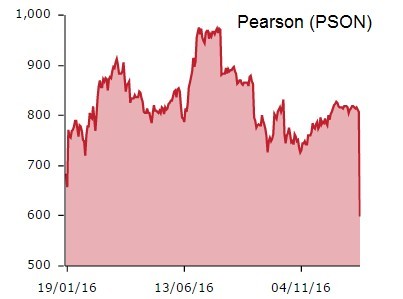
Just as its stock had begun to interest value investors including some high profile fund managers, academic publisher Pearson (PSON) has served up yet another profit warning and flags it will have to cut its dividend.
The shares are in freefall, down 25.8% to 599.5p. That takes them to levels not seen since the financial crisis as the structural problems previously highlighted by Shares in the US higher education market persist.
EARNINGS NOWHERE NEAR PREVIOUS GUIDANCE
Operating profit for 2017 is expected to be in a range between £570m and £630m, around £180m lower than the guidance given at the beginning of 2016.
The £4.9bn cap is also capitulating on its £800m profit target for 2018 and says it will reset its 2017 dividend.
Most analysts assume this means the dividend will be halved from the 52p currently forecast for the 2016 financial year.
The company had previously traded on a 6%-plus yield. Assuming the dividend is cut by 50% the yield based on the current share price would be around 4.3%.
STRUCTURAL PROBLEM
Pearson’s problem, which it has failed to fully acknowledge until now, is that US students are no longer buying expensive academic textbooks.
The company plans to sell its 47% stake in Penguin Random House, which would dilute earnings but relieve pressure on the balance sheet. It says some of the proceeds could be returned to investors, perhaps as a special dividend.
It is also looking to restructure its portfolio through such moves as reducing the cost of e-book rentals.
Investec puts its 835p price target and ‘add’ recommendation under review and comments: ‘Shares are likely to be under material pressure today given guidance capitulation, continuing US higher education pressure and even more restructuring/changes, though Pearson’s actions look right to us.’
Liberum analyst Ian Whittaker, who has been particularly bearish on Pearson for some time, reiterates his ‘sell’ advice and 470p price target.
He says: ‘This is likely to place this stock, in many investors’ minds, in the category of this is the “new newspapers” with all that implies.’





